How to Fertilize a Jacaranda Tree: Strategies to Maximize Health & Beauty
- April 22, 2024
- 1 comment
Learn how to fertilize your Jacaranda tree with our easy strategies to maximize health and beauty, ensuring vibrant blooms and lush foliage. Cultivating a Jacaranda tree is an art that enhances any garden with its striking purple blossoms and intricate greenery. Proper fertilization is crucial to promote hearty growth and spectacular blooms. This guide offers straightforward, effective strategies on how to fertilize your Jacaranda tree, ensuring it remains a stunning feature in your landscape.
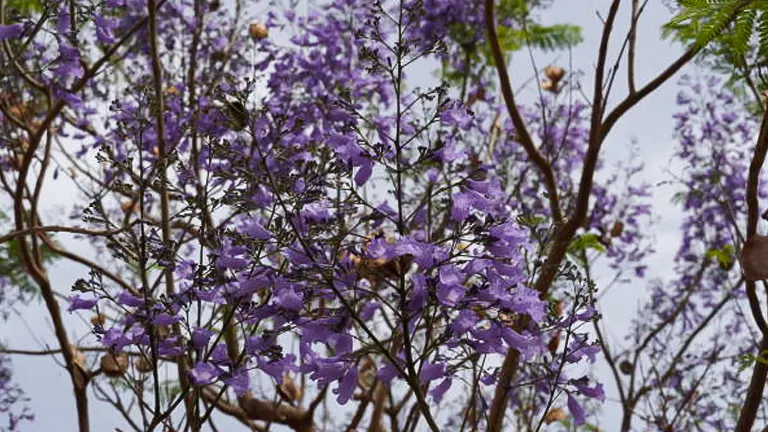
From the type of fertilizer to use, to the timing and methods of application, we will cover all the essentials that every tree enthusiast needs to know. Embrace these tips to not only boost your tree’s health but also its ornamental appeal, making your Jacaranda the envy of the neighborhood.
Table of Contents
- Understanding Your Jacaranda’s Nutrient Needs
- Preparing for Plantation
- Planting Techniques
- Fertilizing Your Jacaranda Tree
- Pruning Techniques
- Routine Care and Maintenance
- Common Mistakes in Jacaranda Care
- Advanced Care Strategies
- Seasonal Care Guide
- Troubleshooting Common Issues
- Conclusion
- FAQs
Understanding Your Jacaranda’s Nutrient Needs
Nutrient Requirements
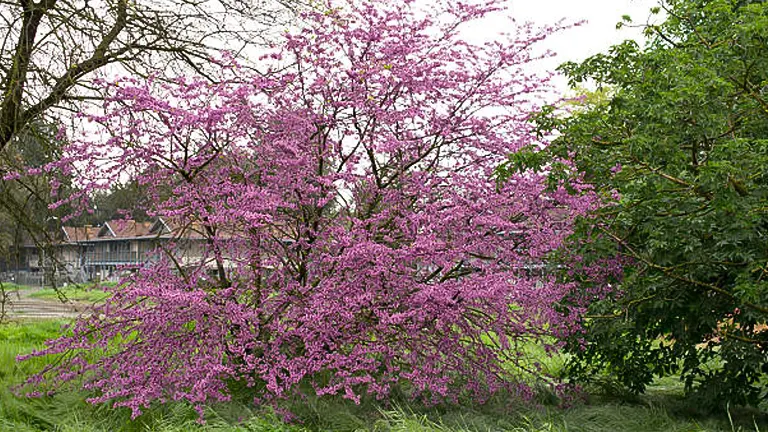
Jacarandas thrive when given a balanced mix of nitrogen (N), phosphorus (P), and potassium (K), which supports their growth at various stages — from leaf development to root strength and disease resistance. The optimal N-P-K ratio for Jacarandas varies slightly depending on the tree’s life stage but generally falls within a balanced range.
- Nitrogen (N): This element is crucial for chlorophyll production and the overall growth of foliage, which is vital for photosynthesis. Nitrogen helps form proteins that are essential for tissue growth and repair.
- Phosphorus (P): Phosphorus is essential for the development of roots and plays a pivotal role in the process of energy transfer and photosynthesis. It helps establish the young saplings during their critical early stages.
- Potassium (K): Potassium is necessary for the synthesis of proteins and starches, contributing to the overall health and vigor of the tree. It regulates the opening and closing of stomata, thus managing water use in drought conditions and enhancing disease resistance.
| Nutrient | Function | Recommended Concentration (young trees) | Recommended Concentration (mature trees) |
|---|---|---|---|
| Nitrogen (N) | Promotes leaf growth and chlorophyll formation | 10% | 12% |
| Phosphorus (P) | Essential for root growth and energy transfer | 20% | 10% |
| Potassium (K) | Aids in protein synthesis and water regulation | 10% | 10% |
Choosing the Right Fertilizer
Organic fertilizers are preferred for Jacarandas because they provide nutrients at a pace that matches the natural absorption rates of these trees. They enhance soil quality by improving its structure and increasing microbial activity, which in turn benefits the tree’s health.
- Types of Organic Fertilizers:
- Composted Manure: Provides a rich source of nutrients slowly over time, which prevents nutrient burn.
- Bone Meal: A great source of phosphorus, particularly beneficial for young Jacarandas to establish robust root systems.
- Blood Meal: High in nitrogen, perfect for mature trees to boost leaf growth and enhance greening.
Special Considerations for Young vs. Mature Trees
- Young Trees: Young Jacarandas benefit significantly from higher phosphorus levels as this nutrient is pivotal for root development. An ideal fertilizer might have an N-P-K ratio of 10-20-10, promoting sturdy and deep root systems which are essential for overall growth and stability.
- Mature Trees: As Jacarandas mature, their nutrient needs shift slightly towards nitrogen to support their extensive foliage. A suitable N-P-K ratio for mature trees would be 12-10-10, which supports leaf development necessary for photosynthesis and overall energy production.
| Tree Age | Ideal N-P-K Ratio | Application Rate | Application Frequency |
|---|---|---|---|
| Young | 10-20-10 | 1 lb per inch of trunk diameter at chest height | Twice a year (Spring and Late Summer) |
| Mature | 12-10-10 | 1.5 lbs per inch of trunk diameter at chest height | Twice a year (Early Spring and Mid-Summer) |
Scientific Insights and Advanced Recommendations
For those with a more technical interest, understanding the molecular absorption rates of Jacarandas can further optimize your fertilization routine. Jacarandas have a moderate to high metabolic rate during their peak growth phases (spring and summer), which correlates with higher nitrogen and phosphorus utilization. This metabolic characteristic suggests that staggered fertilizer applications can be more effective than single, heavy applications, as they mimic natural nutrient availability more closely.
Further Considerations
- Soil Testing: Regular soil tests (every 2-3 years) can provide essential information about nutrient availability and pH levels, which significantly influence nutrient solubility.
- Mulching: Applying organic mulch around the base of Jacaranda trees not only suppresses weeds but also gradually enhances the nutrient quality of the soil as it decomposes.
- Watering Practices: Efficient watering practices enhance fertilizer uptake. Deep, infrequent watering encourages roots to grow deeper, tapping into the deeper-situated nutrients.
Preparing for Plantation
Choosing the Right Location
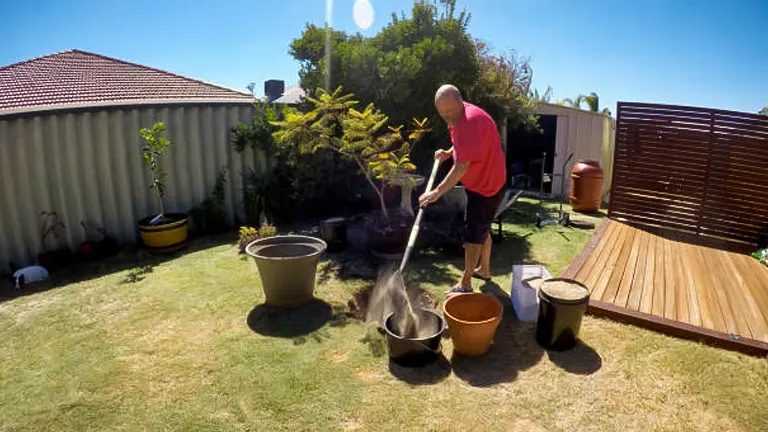
Jacarandas are sun-loving trees that flourish under full sun exposure. The location of planting significantly affects their health and blooming pattern.
- Sunlight Requirements:
- Ideal Exposure: Minimum of 6 hours of direct sunlight per day.
- Benefits of Sunlight: Sunlight is crucial for photosynthesis which fuels growth and bloom production. Adequate light also prevents the foliage from becoming sparse and leggy.
- Site Selection Tips:
- Avoid Shaded Areas: Plant away from buildings or other trees that could cast a shadow, reducing light availability.
- Consider Microclimate: Be aware of your garden’s microclimate. Areas protected from harsh winds but open to sunlight are ideal, as wind can stress the plant and cause moisture loss.
| Aspect | Ideal Condition | Importance |
|---|---|---|
| Sunlight | At least 6 hours daily | Essential for optimal photosynthesis and bloom health |
| Protection | Moderately protected areas | Minimizes stress and physical damage from strong winds |
Soil Requirements and Preparation
The type of soil and its condition play a pivotal role in the successful establishment and growth of Jacaranda trees.
- Soil Type:
- Ideal Soil Composition: Well-draining, fertile, and rich in organic matter. Loamy soils are perfect due to their balanced structure.
- Drainage: Good drainage is critical to prevent waterlogging, which can cause root rot and fungal diseases.
- Soil pH:
- Optimal Range: Slightly acidic to neutral (pH 6 to 7.5).
- Adjusting pH: If the soil test indicates an imbalance, modify pH by incorporating lime (to increase pH) or sulfur (to decrease pH).
- Amending the Soil:
- Compost: Adding well-rotted compost improves soil fertility and enhances its water retention and drainage.
- Perlite or Sand: If the soil is too clayey, adding perlite or coarse sand can help improve its texture and aeration.
| Factor | Ideal Condition | Modification Techniques |
|---|---|---|
| Soil Type | Loamy with high organic content | Add compost, perlite, or sand to adjust texture |
| Drainage | Well-draining | Elevate planting area or add gritty material to improve drainage |
| pH Level | 6.0 – 7.5 | Use lime to raise pH, sulfur to lower pH |
Plant to Plant and Row to Row Spacing
Correct spacing between Jacaranda trees is essential to ensure that each tree has sufficient room to grow both above and below ground.
- Density and Spacing:
- Medium Density: About 15 feet between each tree.
- High Density: Approximately 10 feet between trees for a more compact display or in urban settings.
- Row Spacing: 10-15 feet apart, facilitating adequate air circulation and sunlight penetration.
- Spacing Benefits:
- Air Circulation: Prevents the spread of diseases by reducing moisture retention on leaves and branches.
- Sunlight Access: Ensures all parts of the plant receive sunlight, promoting even growth and flowering.
- Root Expansion: Gives ample room for roots to expand without competing for nutrients and water.
| Planting Density | Tree Spacing | Row Spacing | Notes |
|---|---|---|---|
| Medium Density | 15 feet | 15 feet | Optimal for growth and health in spacious areas |
| High Density | 10 feet | 10-15 feet | Suitable for urban areas where space is limited |
Environmental Considerations
When preparing to plant Jacaranda trees, consider the local environment and climatic conditions:
- Wind Protection: In windy areas, position trees where buildings or natural landscapes can act as windbreaks.
- Topography: Plant on gentle slopes to enhance drainage; avoid low spots where frost or water may collect.
Planting Techniques
Best Times to Plant
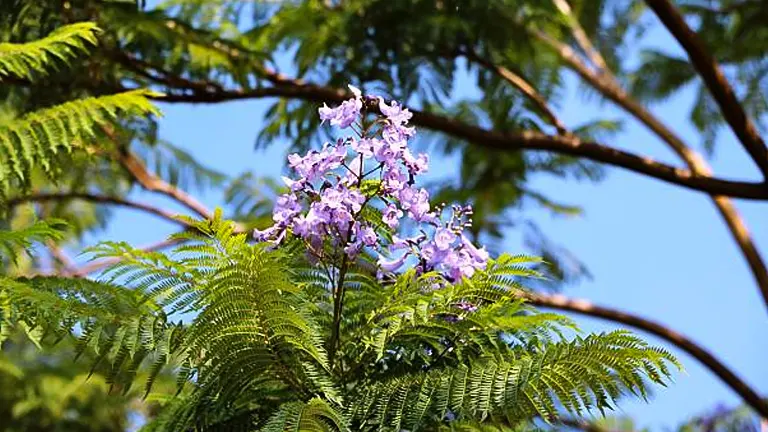
Planting at the optimal time of year is crucial for the Jacaranda to establish itself before either the stress of summer heat or winter cold:
- Ideal Planting Seasons:
- Spring: Early spring, just as the ground thaws and after the last frost date, allows young trees to establish before summer heat sets in.
- Autumn: Planting in early autumn helps the tree establish its roots in still-warm soil while the cool air reduces the demand on the fledgling tree’s sparse leaf canopy.
- Temperature Considerations:
- Avoid planting during temperature extremes. Jacaranda trees are sensitive to frost, which can damage young roots and shoots, and extreme heat which can cause stress to new plantings.
| Season | Timing | Temperature Range | Benefits |
|---|---|---|---|
| Spring | Early (post-frost) | Above 50°F (10°C) at night | Reduces thermal stress; allows time for establishment |
| Autumn | Early (pre-frost) | Below 90°F (32°C) during day | Utilizes warm soil for root growth while reducing foliage stress |
How to Plant
Proper planting technique is essential for ensuring your Jacaranda tree’s health and longevity:
- Hole Preparation:
- Size: Dig a hole that is twice as wide as the tree’s root ball and exactly as deep. This allows the roots to easily spread into the surrounding soil.
- Root Preparation: Gently tease out the roots if pot-bound. This encourages outward growth and prevents girdling (circling of the roots that can strangle the tree).
- Planting Steps:
- Positioning: Place the tree so that the top of the root ball is level with the soil surface. Ensuring it’s not planted too deeply is critical; too deep can cause stem rot.
- Backfilling: Mix removed soil with compost in a 50/50 ratio. Backfill the hole with this mixture, gently tamping down to eliminate air pockets.
- Watering: Water the tree deeply immediately after planting. This helps settle the soil around the roots and provides necessary hydration for the tree to start establishing.
- Mulching: Apply a 2-3 inch layer of organic mulch around the base of the tree, extending out to the drip line (the outer perimeter of the tree’s canopy). Keep the mulch a few inches away from the trunk to prevent moisture accumulation and potential rot.
- Watering Schedule Post-Planting:
- Initial Weeks: Water every day for the first week, then gradually reduce to twice a week for the next two months, depending on the weather and soil type.
- Ongoing Care: After establishment, water requirements will reduce. Water deeply once a week if there is no significant rainfall.
| Step | Details | Purpose |
|---|---|---|
| Hole Preparation | Twice as wide, same depth as root ball | Encourages root spread; prevents root suffocation |
| Root Preparation | Tease out roots if necessary | Promotes healthy outward growth |
| Watering & Mulching | Deep initial watering; organic mulch application | Settles roots; maintains moisture and temperature |
Aftercare
Post-planting care is as crucial as the correct planting process:
- Staking: If planted in a windy area, support the tree with stakes placed on opposite sides of the root ball. Attach with tree ties that are not overly tight to allow some movement.
- Fertilization: Wait at least 6 months before fertilizing to avoid burning the young roots. Initially, use a balanced, slow-release fertilizer to support root and shoot development without overwhelming the tree.
Fertilizing Your Jacaranda Tree
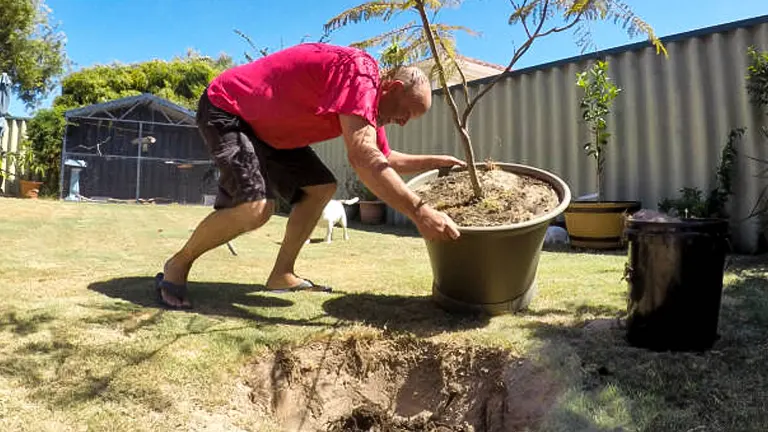
Optimal fertilization is critical for the health, growth, and flowering of Jacaranda trees. The following guide provides step-by-step instructions to ensure effective nutrient management tailored to the developmental stage of the tree.
Step 1: Timing Your Fertilization
- Young Trees: Fertilize every three to four months during the first growing season. This frequent schedule supports the rapid growth phase of young Jacarandas, establishing a strong root system and lush foliage.
- Mature Trees: Reduce the frequency to twice a year:
- Early Spring: Just as the tree exits dormancy and new growth begins, usually late February to March depending on your climate.
- Mid-Summer: To boost energy reserves and prepare for the blooming season, typically in July.
Step 2: Choosing the Right Fertilizer
Select a fertilizer that matches the specific needs of Jacarandas at different growth stages:
- Balanced Fertilizer: Look for a complete fertilizer with an N-P-K ratio of 10-10-10 or 20-20-20, which is ideal for young trees to ensure balanced growth.
- Bloom Boosters: For mature trees, especially those lagging in bloom, choose a fertilizer high in phosphorus, such as a 10-30-10 formulation, to promote vibrant blooms.
Step 3: Preparing to Fertilize
- Soil Testing: Before applying fertilizer, conduct a soil test to determine the existing nutrient content and pH level. This will help you customize the fertilizer type and quantity to your tree’s needs.
- Calculating Dosage: Use approximately 1 pound of fertilizer per inch of trunk diameter measured at chest height. This general rule can be adjusted based on the soil test results and the tree’s overall health and response from previous fertilizations.
Step 4: Application Techniques
- Drip Line Method:
- Spread granular fertilizer evenly around the drip line of the tree — the perimeter on the ground that corresponds to the canopy’s outer edge.
- Avoid placing fertilizer too close to the trunk to prevent root burn and nutrient runoff.
- For liquid fertilizers, dilute as recommended by the manufacturer and apply using a watering can or hose attachment, ensuring even distribution around the drip line.
- Incorporation:
- Lightly till the soil around the drip line to mix the fertilizer into the top layer of soil, which helps with nutrient absorption.
- Water deeply after applying fertilizer to help dissolve the nutrients and carry them down to the roots.
Step 5: Post-Application Care
- Watering: Irrigate the tree immediately after fertilizing to activate the fertilizer and help it seep into the soil, reaching the roots.
- Monitoring: Observe the tree over the following weeks for any signs of distress, such as leaf burn or yellowing, which might indicate over-fertilization.
- Adjustments: Based on the tree’s response (e.g., lush growth, increased blooms, improved foliage color), you may decide to adjust the dosage or frequency in the subsequent applications.
Helpful Tips
- Mulching: Apply a layer of organic mulch around the base of the tree after fertilizing. Mulch helps retain soil moisture and moderates soil temperature, aiding in nutrient uptake.
- Seasonal Adjustments: In colder climates, cease fertilization by the end of August to prevent new growth that could be damaged by early frosts.
- Record Keeping: Maintain a fertilization log to track the types and amounts of fertilizer used and the tree’s growth response. This record can be invaluable for adjusting future care strategies.
Pruning Techniques
Why Prune?
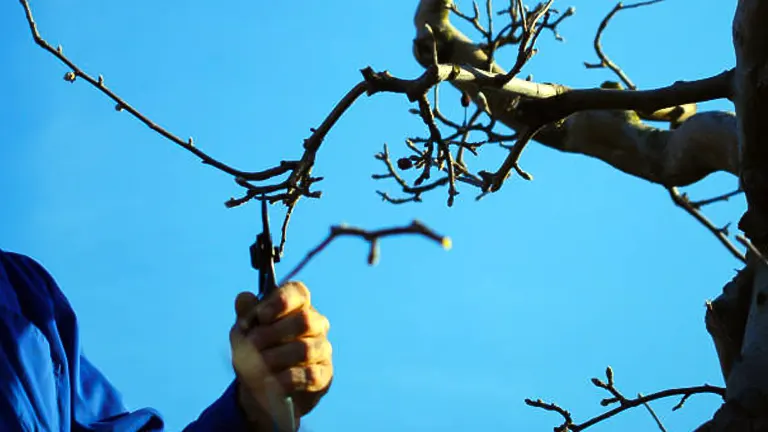
Pruning is not merely a cosmetic procedure for Jacaranda trees; it’s a vital cultural practice that enhances tree health and flowering potential. Proper pruning helps to maintain the structural integrity of the tree, encourages the growth of fresh foliage, and improves flower quality by directing the tree’s energy into fewer, more vibrant blooms.
When to Prune
The ideal time to prune a Jacaranda tree is late winter or early spring, just before new growth starts. This timing ensures that the cuts heal quickly without exposing the tree to harsh winter conditions, and it maximizes the growth response during the active growing season.
How to Prune
- Thinning Out: Remove any weak, diseased, or crossing branches to improve air circulation and light penetration throughout the canopy. This helps to prevent the onset of fungal diseases and promotes more uniform bloom coverage.
- Shaping: Maintain the natural umbrella shape of Jacaranda trees by selectively pruning awkward branches that disrupt the tree’s silhouette. This not only enhances its ornamental appearance but also supports the structural balance of the tree.
- Deadwooding: Regularly remove dead or dying branches to keep the tree healthy and to prevent potential hazards. This practice also diverts the tree’s energy from maintaining unnecessary branches towards more beneficial growth endeavors.
Routine Care and Maintenance
Watering Schedules
Jacaranda trees require consistent moisture, especially during the hot seasons and when they are young and establishing. Water young trees once a week deeply to promote deep root growth, which stabilizes the tree and provides moisture reserves during dry spells. Mature trees benefit from less frequent but still deep watering, which encourages them to withstand periods of drought.
Weed and Pest Control
- Weed Management: Keep the base of Jacaranda trees free from weeds and grass, which compete for nutrients and water. A layer of mulch can suppress weed growth, retain soil moisture, and provide a gradual nutrient supply as it decomposes.
- Pest and Disease Watch: Regularly inspect for signs of pests such as aphids, which can sap strength from the tree, and fungal diseases like rust, which are common in humid climates. Treat infestations and infections early to prevent them from spreading and causing serious damage.
Monitoring Growth

Monitor your Jacaranda’s growth throughout the year to adjust care as needed. Look for signs of nutrient deficiencies (e.g., yellowing leaves for nitrogen shortage), and conduct soil tests every 2-3 years to gauge the soil’s nutrient status. Adjust your fertilization regimen based on these observations and tests to maintain optimal tree health and appearance.
Common Mistakes in Jacaranda Care
Over-Fertilizing
Applying too much fertilizer can lead to salt accumulation, which can burn the roots and damage the tree. Symptoms of over-fertilization include browned, crispy leaves, and stunted growth. If over-fertilization is suspected, flush the soil with plenty of water to dilute nutrient concentrations and halt fertilizer applications until recovery is evident.
Neglecting Pruning
Failure to prune Jacarandas properly can lead to poorly formed trees with weak branches. Without regular pruning, Jacarandas can become top-heavy and susceptible to damage from wind and storms. It’s crucial to establish a regular pruning schedule to maintain the health and structural integrity of the tree.
Improper Watering
Both underwatering and overwatering pose significant risks. Underwatering during hot or dry periods can lead to drought stress, characterized by wilting and leaf drop. Overwatering, particularly in poorly draining soils, can cause root rot and fungal infections. Ensuring proper drainage and monitoring soil moisture can help prevent these issues.
Advanced Care Strategies
Enhancing Flowering
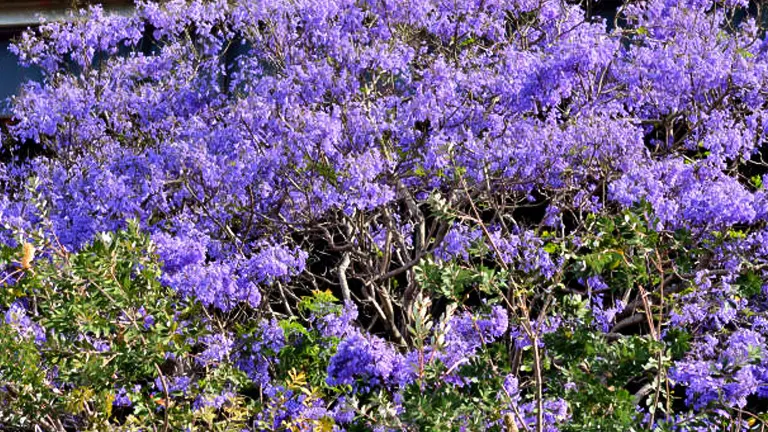
If your Jacaranda is not producing as many blooms as expected, consider adjusting your fertilization strategy. Switch to a fertilizer that has a higher phosphorus content than nitrogen, as phosphorus promotes blooming. A ratio of 5-30-20 (N-P-K) is ideal for encouraging lush, vibrant blooms. Additionally, slightly stressing the tree by reducing watering as the blooming season approaches can trigger the tree to produce more flowers as a survival response.
Dealing with Environmental Stress
Jacarandas are somewhat drought tolerant once established but still benefit from occasional deep watering during prolonged dry spells, especially in hot climates. In cold climates, young Jacaranda trees should be protected from frost, which can damage the roots and kill young shoots. Use frost cloths or move potted Jacarandas to a sheltered location to minimize cold damage.
Soil Health Management
Healthy soil is the foundation of a healthy tree. Incorporate organic material like compost or well-rotted manure into the soil annually to improve its structure and fertility. This not only enhances the soil’s ability to retain water but also its nutrient content, which is crucial for the Jacaranda’s growth and flowering capabilities.
Seasonal Care Guide
Spring
- Pruning: Early spring is the best time to prune Jacarandas, just before the growth season begins. This helps the tree heal faster and direct its energy towards producing a lush canopy and abundant blooms.
- Fertilizing: Apply a balanced fertilizer to support the growth spurt that occurs in spring.
- Watering: Increase watering to help the tree cope with the growing demands of the new season.
Summer
- Pest Control: Inspect regularly for pests, particularly aphids and borers, which are active in summer. Treat infestations promptly to prevent them from causing significant damage.
- Mulching: Add a fresh layer of mulch around the base to conserve moisture, suppress weeds, and keep the roots cool.
- Watering: Maintain consistent moisture, especially during heat waves, to prevent stress and support flowering.
Autumn
- Preparation for Dormancy: Reduce watering as the tree begins to enter dormancy. This is also a good time to apply a phosphorus-rich fertilizer to promote root development and prepare the tree for the next blooming season.
- Cleanup: Remove any fallen leaves and debris around the tree to prevent fungal diseases and pests from overwintering.
Winter
- Frost Protection: In areas where frost is a concern, protect the tree with burlap wraps or relocate potted trees to a protected environment.
- Rest Period: Avoid fertilizing in winter since the tree is dormant and excess nutrients can leach through the soil without being absorbed by the roots.
Troubleshooting Common Issues
Yellowing Leaves
- Cause: Often a sign of overwatering or poor drainage.
- Solution: Reduce watering and improve soil drainage. Also, check for signs of nutrient deficiency, which can be corrected by adjusting fertilizer applications.
Leaf Drop
- Cause: Usually related to watering issues—either too much or too little—or shock from transplanting.
- Solution: Stabilize watering practices to ensure the soil is moist but not soggy. Provide shade and protection if recent transplanting is the cause.
Poor Flowering
- Cause: Could be due to insufficient light, improper pruning, or nutrient imbalance.
- Solution: Ensure the tree is not shaded by buildings or other plants. Prune correctly to encourage flowering and adjust the fertilization schedule, particularly increasing phosphorus intake.
Related Post
- How to Fertilize a Mango Tree Effectively: Tips and Tricks for Healthy Growth
- How to Fertilize Apple Trees: Essential Tips for a Bountiful Harvest
- How to Fertilize Lemon Trees: Secrets for Thriving Citrus
- How to Fertilize Avocado Tree: A Step-by-Step Guide for Lush Growth
- How to Fertilize Bougainvillea: A Complete Guide for Stunning Blooms
Conclusion
Maximizing the health and beauty of a Jacaranda tree involves more than just regular fertilization. It requires a holistic approach that includes proper planting, routine care, seasonal adjustments, and proactive troubleshooting. By understanding the specific needs of your Jacaranda and responding to changes in its health and environment, you can ensure it remains a vibrant and flourishing part of your landscape. This guide aims to provide you with the comprehensive knowledge needed to nurture your Jacaranda effectively, from soil preparation to advanced flowering techniques. Enjoy the stunning beauty of your Jacaranda tree, a testament to the care and attention you invest in its wellbeing.
FAQs
- What is the best type of fertilizer for a young Jacaranda tree?
For young Jacaranda trees, it’s best to use a phosphorus-rich fertilizer to encourage strong root development. Look for a fertilizer with a higher middle number in the N-P-K ratio, such as a 10-20-10 formulation. This promotes healthy root growth, which is essential for the overall vitality and stability of young trees. - How often should I fertilize a mature Jacaranda tree and why?
Mature Jacaranda trees should be fertilized twice a year: once in early spring to kickstart growth after the dormant winter period, and once in mid-summer to bolster health and enhance blooming potential. This schedule helps maintain an optimal balance of nutrients throughout the year, supporting robust health and vibrant blooms. - Can over-fertilizing harm my Jacaranda tree?
Yes, over-fertilizing can be detrimental to Jacaranda trees. Excessive fertilizer can lead to nutrient burn, where the roots are damaged by high levels of chemical salts. This can manifest as scorched, browning leaves and stunted growth. To avoid this, always apply fertilizer according to the package instructions and only as needed based on the tree’s growth and health. - What signs indicate that my Jacaranda tree needs fertilizer?
Signs that your Jacaranda may need fertilizing include slow leaf growth, pale or yellowing leaves, and a lack of vibrant blooms. These symptoms suggest nutrient deficiencies, which can typically be remedied with a well-balanced fertilizer applied at the recommended rates. - Is there a particular type of fertilizer that is best for promoting blooms in Jacaranda trees?
To encourage blooming in Jacaranda trees, use a low-nitrogen, high-phosphorus fertilizer. A formulation such as 5-30-20 is ideal as it minimizes lush foliage growth while maximizing bloom production. This type of fertilizer supports the tree in channeling more energy into creating flowers rather than leaves. - How do I apply fertilizer to a Jacaranda tree correctly?
Fertilizer should be applied around the drip line of the Jacaranda tree, which is the outer perimeter of the tree’s canopy where it would naturally drip rain onto the ground. Spread the fertilizer evenly under the canopy and lightly incorporate it into the top inch of soil, then water thoroughly to help dissolve the nutrients and carry them to the roots. - What is the impact of soil pH on fertilizing Jacaranda trees?
Soil pH can significantly impact the effectiveness of fertilizers on Jacaranda trees. Jacarandas prefer slightly acidic to neutral soil (pH 6-7.5). If the soil is too alkaline, it can lock up phosphorus and iron, making them unavailable to the tree. This can be corrected by applying soil amendments like sulfur or peat moss to lower the pH, or using fertilizers that are formulated for alkaline conditions. - Should I fertilize my Jacaranda tree during the winter?
Fertilizing Jacaranda trees during the winter is not recommended. This is the tree’s dormant period, and it will not efficiently absorb nutrients due to reduced metabolic activity. Fertilizing at this time can lead to nutrient runoff and waste, as well as potential environmental harm. The best practice is to resume fertilizing in the early spring when the tree returns to active growth.
To keep your Jacaranda thriving, apply the right fertilizer at key times and in proper amounts. This simple practice will enhance its health and beauty, ensuring spectacular blooms and lush foliage season after season.

Benjamin Brooks
Forestry AuthorGreetings! I'm Benjamin Brooks, and my journey over the past 15 years has revolved around the fascinating realms of content creation, expertise in snow clearing, and the intricate world of lumberjacking and landscaping. What began as a simple curiosity about the natural world and heavy machinery has evolved into a passionate profession where my love for crafting words intertwines seamlessly with my lumberjacking and garden skills.







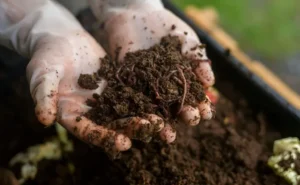





Hi Benjamin, Thanks for your information on the Jacaranda Tree. I've been looking for advice on how to care for a Jacaranda but without much luck. I have a mature full canopy tree - I think it's about 18 -20 mtrs across and it has a beautiful weeping habit. It blooms beautifully and the leaves come on in full abundance in early summer. I have recently removed two very large elkhorns from it's trunk, covering easily 90% of it's girth at one point about chest high. The remaining bark looks frightening, with a great slab of it appearing to want to fall off. Can you suggest further reading about this? I'm in a subtropical part of the world, very humid and hot in Summer - Brisbane, Australia.
Kerry Youdale
January 5, 2025 8:09 am